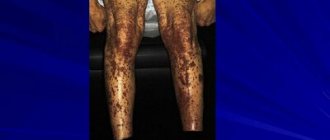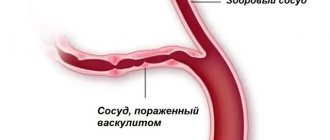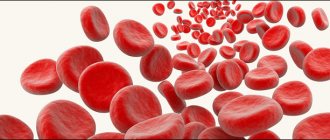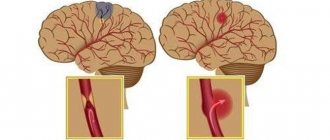A common disease of immune origin, manifested as inflammation of the walls of the capillaries of the skin and internal organs, is hemorrhagic vasculitis. This is an aseptic pathology, which is characterized by the active formation of immune complexes and damage to the wall of microvessels with an increase in their permeability. The disease is systemic in nature and affects people at any age, but the largest number of patients are among children and adolescents aged 4 to 12 years. Boys get sick 2-2.5 times more often than girls.
What kind of disease is this
This disease is of an infectious-allergic nature: the main cause of hemorrhagic vasculitis is the presence in the blood of patients of immune complexes and active components of the protective system of proteolytic enzymes. Immune complexes accumulate in the bloodstream, and with an excessive amount of antigens or a lack of antibodies, protein formations are deposited on the endothelium of the microvascular wall. Factors contributing to the development of the disease are:
- bacterial and viral respiratory infections suffered 2-4 weeks before the onset of the disease, which account for up to 60-80% of all cases of the disease;
- foci of chronic infection (sinusitis, tonsillitis, caries, etc.);
- some medications, mainly of antibiotic action;
- potentially allergenic foods (strawberries, citrus fruits, chocolate, eggs, etc.);
- administration of a vaccine or serum;
- hypothermia and dampness or prolonged exposure to the sun.
There is evidence of a hereditary predisposition to the disease. In some cases, it is impossible to find out which factor served as the “trigger” for the patient’s body.
List of sources
- Lyskina G. A. Systemic vasculitis. In the book: Pediatric rheumatology. Guide for doctors / Ed. A. A. Baranova, L. K. Bazhenova. M.: Medicine, 2002. pp. 221–270.
- Kulaga V.V., Romanenko I.M., Afonin S.L. Allergic diseases of the blood vessels of the skin. Lugansk: “Etalon-2”, 2006. 168 p.
- A practical guide to childhood diseases, edited by prof. Kokolina V.F. and prof. A.G. Rumyantsev, volume IV. Hematology/oncology of childhood (edited by Rumyantsev A.G. and E.V. Samochatova). Medical practice – M. Moscow 2004 Zinovieva G.A., Frolkova E.V. Hemorrhagic vasculitis. Clinic and treatment // ros. pediatrician, journal — 1998. -N12. P.24-26.
- Krivosheev O.G., Gulyaev CB, Semenovykh A.G. Modern principles of treatment of Henoch-Schönlein purpura // Doctor. 2007. No. 4. -P.54-55.
Manifestations of the disease
The symptoms of hemorrhagic vasculitis are quite varied. The most characteristic external sign is skin damage, manifested in the form of so-called purpura - a bright rash in the form of small purple-bluish spots, symmetrically appearing on the legs and feet, and with the development of the disease rising higher, to other parts of the body. In addition to purpura, other types of rash may appear on the patient’s body - erythema, petechiae, vesicles. In severe cases, necrotic areas of skin may appear.
In addition, more than 2/3 of patients have damage to the joint surface. It is accompanied by pain and swelling, which can last for several days. The most severe symptom of hemorrhagic vasculitis is abdominal pain - a consequence of hemorrhagic damage to the intestinal wall. The nature of the pain is similar to manifestations of appendicitis, peptic ulcer or intestinal obstruction. In some cases, the presence of blood is detected in stool and vomit. Some patients develop glomerulonephritis, cough, and shortness of breath.
There is a definite difference between the manifestations of the disease in children and adults.
Hemorrhagic vasculitis in children is characterized by striking symptoms, including:
- acute onset and course of the disease;
- the presence of fever in about a third of patients;
- loose stools streaked with blood;
- abdominal syndrome;
- manifestations of glomerulonephritis with the presence of protein and red blood cells in the urine.
Cases of hemorrhagic vasculitis in adults, as a rule, are characterized by blurred, insignificant manifestations at the onset of the disease. Abdominal syndrome is present in no more than half of patients, mostly without nausea and vomiting. When the kidneys are damaged, chronic glomerulonephritis and chronic renal failure almost always develop.
Are you experiencing symptoms of hemorrhagic vasculitis?
Only a doctor can accurately diagnose the disease. Don't delay your consultation - call
YOU can call us: 8 (8452) 98-84-68 and +7-967-500-8468 or
Hemorrhagic vasculitis (synonyms: Henoch-Schönlein purpura, Henoch-Schönlein disease, rheumatic purpura, allergic purpura) is the most common disease from the group of systemic vasculitis. It is based on aseptic inflammation of the walls of microvessels, multiple microthrombotic formation, affecting the vessels of the skin and internal organs (most often the kidneys and intestines).
The main reason that causes this disease is the circulation of immune complexes and activated components of the complement system in the blood. In a healthy body, immune complexes are removed from the body by special cells - cells of the phagocytic system. Excessive accumulation of circulating immune complexes under conditions of predominance of antigens or insufficient formation of antibodies leads to their deposition on the endothelium of the microvasculature with secondary activation of complement system proteins along the classical pathway and secondary changes in the vascular wall.
As a result, microthrombovasculitis develops and changes occur in the hemostatic system: activation of platelets, circulation of spontaneous aggregates in the blood, pronounced hypercoagulation, decrease in plasma antithrombin III, thrombopenia, increased level of von Willebrand factor, depression of fibrinolysis.
In 1837, the famous German physician JL Schönlein described “anaphylactic purpura.” In 1874 his compatriot E.N. Henoch published a valuable work on the same disease.
The name “ hemorrhagic vasculitis ,” used only in Russia, was introduced in 1959 by the outstanding rheumatologist V. A. Nasonova. Henoch-Schönlein purpura still prevails .
Etiology
In the majority of patients (66-80%), the development of the disease is preceded by an upper respiratory tract infection.
The manifestation of the disease after typhus, paratyphoid A and B, measles, and yellow fever is described.
Other potential triggers for the disease may include:
- medications (penicillin, ampicillin, erythromycin, quinidine, enalapril, lisinopril, chlorpromazine)
- food allergy
- insect bites
- hypothermia
Sometimes hemorrhagic vasculitis complicates the development of pregnancy, periodic illness, diabetic nephropathy, liver cirrhosis, and malignant neoplasms.
Classification
By form
- cutaneous and skin-articular:
- simple
- necrotic
- with cold urticaria and swelling
- abdominal and cutaneous-abdominal
- renal and cutaneous-renal
- mixed
With the flow
- fulminant course (often develops in children under 5 years of age)
- acute course (resolved within 1 month)
- subacute (allowed up to three months)
- prolonged (allowed up to six months)
- chronic.
By degree of activity
- I degree of activity - the condition is satisfactory, body temperature is normal or subfebrile, skin rashes are not abundant, all other manifestations are absent, ESR is increased to 20 millimeters per hour.
- II degree of activity - a state of moderate severity, severe skin syndrome, body temperature rises above 38 degrees (fever), severe intoxication syndrome (headache, weakness, myalgia), severe articular syndrome, moderate abdominal and urinary syndrome. In the blood, the number of leukocytes, neutrophils, eosinophils is increased, ESR will be increased to 20-40 millimeters per hour, albumin content decreases, dysproteinemia.
- III degree of activity - the condition will be severe, symptoms of intoxication are pronounced (high fever, headache, weakness, myalgia). Skin syndrome, articular, abdominal (paroxysmal abdominal pain, vomiting, mixed with blood), severe nephritic syndrome will be expressed, and there may be damage to the central nervous system and peripheral nervous system. In the blood there is a pronounced increase in leukocytes, an increase in neutrophils, an increase in ESR above 40 millimeters per hour, there may be anemia, a decrease in platelets.
Clinical picture As a rule, hemorrhagic vasculitis is benign. Usually the disease ends in spontaneous remission or complete recovery within 2-3 weeks from the moment the first skin rash appears. In some cases, the disease becomes relapsing. Severe complications due to damage to the kidneys or intestines are possible.
There are several clinical forms of hemorrhagic vasculitis:
Simple (cutaneous) form; Articular (rheumatoid) form; Abdominal form; Kidney form; Lightning form; Combined lesion (mixed form). Clinically, the disease manifests itself with one or more symptoms:
Skin lesions are the most common symptom[7] and are one of the diagnostic criteria for the disease. A characteristic hemorrhagic rash is observed - the so-called palpable purpura, the elements of which rise slightly above the surface of the skin, which is invisible to the eye, but is easily identified by touch. Often individual elements merge and can form continuous fields of significant area. Sometimes individual elements become necrotic. At the onset of the disease, the rash may be petechial in nature.
At the onset of the disease, the rashes are always localized in the distal parts of the lower extremities. Then they gradually spread to the thighs and buttocks. Very rarely the upper limbs, abdomen and back are involved in the process.
After a few days, the purpura in most cases fades, acquires a brown color due to pigmentation and then gradually disappears. With a recurrent course, areas of pigmentation may persist. There are never scars (with the exception of isolated cases with necrotization of elements and the addition of a secondary infection).
Joint syndrome - often occurs together with skin syndrome, occurs in 59-100% of cases[5]. Joint damage develops more often in adults than in children.
The favorite localization is the large joints of the lower extremities; the elbow and wrist joints are less often involved.
Characterized by migrating pain in the joints, occurring simultaneously with the appearance of skin rashes. In about a quarter of cases (especially in children), joint pain or arthritis precedes skin lesions.
A combination of articular syndrome with myalgia (muscle pain) and swelling of the lower extremities is possible.
The duration of articular syndrome rarely exceeds one week.
Abdominal syndrome, caused by damage to the gastrointestinal tract, occurs in approximately 2/3 of all patients. It manifests itself as spastic abdominal pain, nausea, vomiting, gastrointestinal bleeding (moderate, non-dangerous bleeding occurs frequently - up to 50% of cases; severe - less often, life-threatening - in no more than 5% of cases). Severe complications such as intussusception, perforation, and peritonitis are possible. An endoscopic examination reveals hemorrhagic or erosive duodenitis, less often erosion in the stomach or intestines (any localization is possible, including the rectum).
Renal syndrome: the prevalence has not been precisely established; there is a significant range of data in the literature (from 10 to 60%). More often it develops after the appearance of other signs of the disease, sometimes one to three weeks after the onset of the disease, but in isolated cases it may be its first manifestation. The severity of renal pathology, as a rule, does not correlate with the severity of other symptoms. Clinical manifestations of kidney damage are varied. Usually isolated micro- or macroglobulinuria is detected, sometimes combined with moderate proteinuria. In most cases, these changes pass without a trace, but some patients may develop glomerulonephritis[7]. Nephrotic syndrome may develop.
Morphological changes in the kidneys range from minimal to severe nephritis with crescents. Electron microscopy reveals immune deposits in the mesangium, subendothelium, subepithelium, and glomeruli of the kidneys. They include IgA, mainly the 1st and less often the 2nd subclass, IgG, IgM, C3 and fibrin.
Lung damage: occurs in isolated cases. Patients with pulmonary hemorrhage and pulmonary hemorrhages are described. Damage to the nervous system: occurs in isolated cases. Patients with the development of encephalopathy, with minor changes in mental status, are described; there may be severe headaches, seizures, cortical hemorrhages, subdural hematomas and even cerebral infarction. The development of polyneuropathy has been described. Damage to the scrotum: occurs in children, no more than 35%, and boils down to swelling of the scrotum (which is associated with hemorrhages in its vessels). Lightning form. It is based on a hyperergic reaction, the development of acute necrotizing thrombusculitis. The disease most often develops in the first or second year of life, 1-4 weeks after a childhood infection (chickenpox, rubella, scarlet fever, etc.). Characterized by symmetrical extensive hemorrhages, necrosis, and the appearance of cyanotic areas of the skin (hands, feet, buttocks, face), which are confluent in nature. In the future, gangrene of the hands and feet, coma, and shock may develop.
Features of hemorrhagic vasculitis in children:
The severity of the exudative component; Tendency to generalize; Limited angioedema; Development of abdominal syndrome; Acute onset and course of the disease; Tendency to relapsing course.
Laboratory signs Nonspecific. An important sign to suspect the disease is an increase in the concentration of IgA in the blood serum.
RF is detected in 30% - 40% of patients. In children, an increase in ASL-O titer is observed in 30% of cases. Increases in ESR and CRP correlate with the degree of vasculitis activity.
Diagnostic criteria[edit | edit wiki text] There are classification criteria for hemorrhagic vasculitis recognized by the international community of rheumatologists, which have been successfully used in diagnosis for many years (since 1990)[8].
There are four of them, each given a clear definition.
Palpable purpura. Slightly raised hemorrhagic skin changes not associated with thrombocytopenia. Age less than 20 years. The age of onset of the disease is less than 20 years. Stomach ache. Diffuse abdominal pain, worse after eating. or intestinal ischemia (there may be intestinal bleeding). Detection of granulocytes during biopsy. Histological changes revealing granulocytes in the wall of arterioles and venules. The presence of 2 or more of any criteria in a patient allows a diagnosis to be made with a sensitivity of 87.1% and a specificity of 87.7%.
Other systems of classification and differential diagnostic criteria have also been proposed [9] [10].
Treatment First, a diet is necessary (allergenic foods are excluded). Secondly, strict bed rest. Thirdly, drug therapy (antiplatelet agents, anticoagulants, corticosteroids, immunosuppressants - azathioprine, as well as antithrombotic therapy). The following drugs are used:
disaggregants - chimes 2-4 milligrams/kilogram per day, trental intravenous drip. heparin in a dosage of 200-700 units per kilogram of body weight per day subcutaneously or intravenously 4 times a day, gradually withdrawn with a decrease in the single dose. activators of fibrinolysis - nicotinic acid. In severe cases, plasmapheresis or glucocorticosteroid therapy is prescribed. In exceptional cases, cytostatics such as Azathioprine or Cyclophosphamide are used. In general, the course of the disease is favorable, and immunosuppressive or cytostatic therapy is rarely used (for example, in the development of autoimmune nephritis).
Children must be registered at a dispensary. Conducted over 2 years. For the first 6 months, the patient visits the doctor monthly, then once every 3 months, then once every 6 months. Prevention is carried out by sanitation of foci of chronic infection. Regularly examine stool for helminth eggs. Such children are contraindicated in sports, various physical procedures and exposure to the sun.
Diagnostic methods
Since in children the disease manifests itself with bright, acute symptoms from the very beginning, there are, as a rule, no problems with making a diagnosis. Diagnosis of hemorrhagic vasculitis in adults is much more difficult, especially in the absence of a characteristic rash at the onset of the disease. As a rule, it is based on laboratory tests, which include:
- blood tests - general, biochemical, coagulogram;
- urine examination for hematuria, proteinuria, cylindruria, Nechiporenko and Zimnitsky tests, biochemical analysis;
- stool test for the presence of blood.
An important stage of diagnosis, which allows us to establish the degree of damage to internal organs, is instrumental studies - ultrasound of the abdominal cavity and kidneys, ultrasound of the renal vessels, gastroscopy. In severe cases of the disease, a biopsy of the skin and kidneys is prescribed to determine the size of immunoglobulin deposits and the permeability of the vascular wall.
Diagnosis of hemorrhagic vasculitis
At the Yauza Clinical Hospital, patients with suspected Henoch-Schönlein disease are prescribed the following set of examinations:
- general blood analysis;
- general urine analysis;
- coagulogram;
- determination of the level of antistreptolysin-O, IGA in peripheral blood;
- tissue biopsy of the affected organ or part of the body, followed by histological examination of the biopsy.
To make a diagnosis of hemorrhagic vasculitis, the patient must have two or more diagnostic criteria:
- specific rashes not associated with low platelet levels;
- manifestation of the disease before the age of 20 years;
- widespread abdominal pain that worsens after eating, intestinal bleeding;
- granulocytic infiltration of the walls of microvasculature vessels, which is confirmed histologically.
How to treat?
In cases of a mild form of the disease, treatment of hemorrhagic vasculitis can be done without compulsory hospitalization of the patient, but in any case it will require bed rest. During the acute period, a hospital stay under the constant supervision of doctors is necessary. An acute disease is usually cured within about 2 months; if the disease is protracted, the duration of treatment can increase to six months.
Therapy includes medication as indicated. In severe cases of the disease, glucocorticosteroids may be prescribed, as well as plasmapheresis or transfusion therapy for children. In the presence of allergic manifestations, antihistamines are prescribed. The diet for hemorrhagic vasculitis is aimed at excluding potentially allergenic foods that can worsen the patient’s condition - citrus fruits, strawberries, chocolate, coffee, eggs, etc. For severe renal and abdominal syndrome, special diets are prescribed.
Diet
Hypoallergenic diet
- Efficacy: therapeutic effect after 21-40 days
- Timing: constantly
- Cost of products: 1300-1400 rubles. in Week
Diet Table No. 1
- Efficacy: therapeutic effect after 3 weeks
- Terms: 2 months or more
- Cost of products: 1500 - 1600 rubles. in Week
Diet 7 table
- Efficacy: therapeutic effect after a week
- Terms: 1 month or more
- Cost of products: 1200-1300 rubles per week
A hypoallergenic diet is prescribed, which involves excluding obligate allergens from the diet: milk, fish, citrus fruits, chocolate, cocoa, orange and red vegetables/fruits, as well as extractive substances. For abdominal syndrome, a modified Table No. 1 according to Pevzner is indicated until it is completely relieved. For nephritis - dietary Table No. 7 with a gradual transition to a hypochloride diet.
Forecast
In children, hemorrhagic vasculitis often occurs in an acute form. Symptoms disappear after 1 - 1.5 months in 75% of cases. In ¼, kidney damage occurs with further transition to chronic inflammation.
An unfavorable prognosis awaits cases of rapid progression of renal pathology with the development of failure. Death from stomach or intestinal bleeding or peritonitis is a rare occurrence.
Modern medical capabilities are sufficient to cure children. All symptoms must be properly assessed by parents. Their manifestation is a mandatory indication for an urgent visit to a pediatrician.
Mechanism of vascular damage
The main factor of damage in hemorrhagic vasculitis is special complexes formed from immune cells. They are called anaphylotoxins for their destructive properties. Under normal conditions they disintegrate. In a sick person, complexes accumulate and become antigens.
Deposition on the inner wall of blood vessels with a change in permeability causes blood circulation problems:
- platelets are activated;
- the plasma content of specific antithrombin decreases;
- the process of fibrinolysis is blocked.
As a result, a mass of microthrombi is formed in small vessels against the background of allergic inflammation and reduced blood clotting.
How to prevent exacerbations?
After discharge from the hospital, the patient should not forget about his illness at home. Of course, by that time he will already know everything about the nature of the disease, prevention of exacerbations, behavior in everyday life, nutrition and daily routine. Having immersed himself in a homely atmosphere, the patient will not take any medications without a doctor’s prescription, will not attack foods that can provoke a relapse (allergens), but will eat well and will take quiet, easy walks in the fresh air every evening.
In addition, the following are contraindicated for a person:
- Excessive anxiety, mental stress;
- Vaccinations (possible only for health reasons);
- Hard physical labor (children are exempt from physical education lessons);
- Hypothermia;
- Administration of immunoglobulins (antistaphylococcal, antitetanus, etc.).
Due to the fact that hemorrhagic vasculitis is predominantly a childhood disease, special recommendations are provided for children (or parents?):
- Every six months the child visits the attending physician (in the absence of exacerbations);
- Clinical observation for at least 5 years if the kidneys remain healthy, but if they are damaged, control may be lifelong;
- Children are completely exempt from physical education for a year, then move to the preparatory group;
- A mandatory visit to the dentist and otolaryngologist is required 3 times a year;
- Regular urine tests (general and Nechiporenko) and fecal tests for helminths;
- Vaccinations are excluded for 2 years, and after this time, routine vaccination is carried out, but with the permission of the attending physician and under “antihistamine cover”;
- Compliance with an anti-allergenic diet – 2 years;
Advice to parents or other relatives about treatment at home, relapse prevention, nutrition and behavior at school and at home.
Forms, varieties, and symptoms
The symptoms of the disease depend on the form of vasculitis and the variety.
Early symptoms are similar to those of most infectious and inflammatory diseases: fever, weakness, headache, fatigue, muscle pain. As the process progresses, symptoms of the primary and secondary forms of the disease appear. The primary form is an independent disease, which consists of inflammation of a vessel of immune origin, autoimmune vasculitis. The secondary form is a consequence and symptom of a systemic disease, as well as a consequence of infections, helminth infections, exposure to toxins, chemicals, and radiation. Among the systemic diseases, the symptoms of which can be vasculitis, are diabetes mellitus, lupus erythematosus, and sarcoidosis.
Cutaneous
Cutaneous vasculitis affects the vessels of the dermis of small or medium diameter, but does not affect the vessels of the internal organs. It is diagnosed by biopsy, since skin vasculitis is similar in external symptoms to some diseases:
- capillary effusions of the skin - purpura;
- damage to skin capillaries - petechiae;
- urticaria, nodules;
- reticular levedo due to stagnation of blood in the capillaries.
Skin vasculitis can develop against the background of systemic diseases, and then the symptoms are supplemented by fever and joint pain.
Allergic
Manifested by the following symptoms:
- nodules, hemorrhagic, erythematous spots and rashes;
- skin infarction - formation of a black crust in the area of the rash;
- hemorrhages under the toenails;
- pain in joints and muscles;
- burning, squeezing pain or itching in areas of rash;
Allergic vasculitis most often manifests itself as a rash on the thighs, legs, feet, and in the generalized form, rashes are added on the forearms and torso.
The group of allergic vasculitis includes erythema induratum of Bazin, acute and chronic erythema nodosum, Behcet's disease, temporal angiitis, which have specific symptoms.
Acute erythema nodosum is characterized by large size nodes and a change in the color of the skin underneath them from red to greenish.
Behcet's disease mainly affects the mucous membranes of the eyes, mouth and skin with the formation of erosions and ulcers.
With temporal or senile angitis, older women suffer from severe and prolonged pain in the temple area.
System
Occurs when immune mechanisms are disrupted in various systemic diseases, which are characterized by damage to connective tissue (rheumatism, granulomatosis, lupus erythematosus, etc.)
With Wegener's granulomatosis, the disease manifests itself with the following symptoms:
- destructive changes in the walls of blood vessels in the respiratory tract and kidneys;
- ulcerated granulomas on the mucous membrane of the nose, mouth, bronchi;
- glomerulonephritis;
- severe complications on internal organs, skin, nervous system, and organs of vision.
With rheumatism, it spreads to the entire body and manifests itself depending on the stage of development of the disease. In addition to the skin, the vessels of internal organs and the brain are affected, with the risk of internal bleeding.
Cryoglobulinemic
One of the varieties of the systemic variety of the disease is cryoglobulinemic vasculitis, in which cryoglobulin proteins appear in blood cells, depositing on the walls of blood vessels and destroying them.
The disease has a progressive form, and its characteristic symptom (except for those common to all types of the disease) is damage to peripheral nerves and impaired sensitivity. If not adequately treated, cryoglobulinemic vasculitis can cause speech loss and motor paralysis.
Urticarial vasculitis
Urticarial vasculitis, or angiitis, is one of the types of allergic forms of the disease, which is characterized by chronic inflammation of the superficial vessels of the skin.
At the initial stage of development, it is often diagnosed as chronic urticaria. The disease is characterized by the following symptoms:
- wave-like current;
- the appearance of hemorrhagic spots, nodules, blisters on the skin;
- burning sensation in the affected areas;
- headache, in joints, lower back, muscles, stomach;
- elevated temperature;
- glomerulonephritis.
Diagnosed by immunofluorescence and histological examination of the affected areas of the dermis.
Treatment regimen and nutritional features
Treatment of a child with hemorrhagic vasculitis must begin in a hospital setting. Three weeks of bed rest followed by extension is usually suggested.
Complex therapy necessarily includes a strict diet. The following are excluded from the diet:
- coffee, cocoa, products containing them (all types of chocolate);
- fruits of citrus trees (oranges, lemons, tangerines, grapefruits);
- fresh berries;
- nuts;
- candies and sweets;
- butter dough;
- eggs;
- canned foods.
Meat and fish dishes are prepared only boiled. Spicy and salty seasonings and pickled vegetables are not allowed.
If abdominal syndrome is suspected, a gentle semi-liquid diet is prescribed, as for peptic ulcer disease (table No. 1). If kidney damage is detected, then dietary table No. 7 is used.
If bed rest is violated early, the rash may recur (orthostatic purpura)
What to do during the recovery period?
Treatment during the rehabilitation period is aimed at preventing relapses and transition to a chronic form. The child needs:
- comply with dietary requirements throughout the year;
- identify and treat chronic foci of infection;
- monitor for possible hypothermia;
- protect yourself from viral infections;
- Do not allow sunbathing.
Dental sanitation is required
Clinical follow-up is carried out by a rheumatologist over the next 3–5 years. During this period, vaccinations are contraindicated.
If the kidneys and intestines are damaged, special diets should be followed until complete recovery.
Drug treatment
All medications when treating a child with hemorrhagic vasculitis are used very carefully, taking into account individual sensitivity. Doses of medications are calculated based on the child’s weight individually. Not recommended:
- antibiotics,
- sulfonamides,
- calcium supplements,
- ascorbic acid.
The treatment process must resist the mechanisms of damage.
To remove toxins and waste from the intestines, medications with a sorbing effect (enterosorbents) are used:
- Thioverol,
- Polyphepan,
- Nutricleans.
They are prescribed for a period of one to three months.
Antiplatelet agents - prevent thrombosis, improve microcirculation. Are used:
- Chime,
- Aspirin,
- Ticlopedin.
The duration of the course depends on the complete relief of purpura. Reopoliglyukin, Reomacrodex - solutions for intravenous administration, improve blood viscosity.
Heparin is the main anticoagulant that suppresses blood clotting factors.
Antihistamines are aimed at suppressing food and drug allergies. Drugs of choice:
- Tavegil,
- Terfen,
- Diazolin,
- Fenkarol.
Antibacterial treatment is prescribed for:
- active infection, possibly causing vasculitis;
- in the stage of exacerbation of chronic inflammatory foci;
- obvious glomerulonephritis;
- persistent course of purpura.
In such cases, the use of macrolide antibiotics is justified:
- Sumameda.
- Klacida.
Glucocorticoids are hormonal anti-inflammatory drugs to suppress the inflammatory response. Prescribed in severe and moderate conditions.
In the case of an undulating course of hemorrhagic vasculitis, additional agents are used in treatment to stabilize the inflammation.
Nonsteroidal anti-inflammatory drugs have the ability to suppress a number of enzymes, promote the synthesis of essential prostaglandins, and increase the mobility of neutrophils. Ortofen is used and should not be combined with Aspirin. Plaquenil prevents sensitization of cell membranes.
A group of cytostatics is used if:
- there are contraindications to the prescription of hormonal therapy;
- despite treatment, nephritis progresses or recurs;
- the therapy being carried out is ineffective.
In the treatment of children, the least severe drug is used - Azathioprine.
Vitamin supplements (vitamin E, Retinol, Rutin) enhance other medications, stimulate defense, and remove toxins.
Clinical classification
Clinicians distinguish the following forms of the disease:
- simple or cutaneous - the whole process is limited to skin manifestations;
- skin-articular - in addition to the characteristic skin rashes, there are signs of inflammation of the joints;
- skin-abdominal - against the background of skin changes, symptoms of dysfunction of the stomach and intestines appear;
- renal - rare, accompanied by damage to the renal vessels with impaired filtration and urine excretion;
- mixed (combined) - there are changing symptoms of different forms.
Based on the type of disease, the following are distinguished:
- fulminant form - characterized by a rapid course, lasts several days, occurs in children under 5 years of age;
- acute - the disease has a sudden onset and lasts up to 30 days;
- subacute - lasts up to three months;
- protracted - clinical manifestations last for six months;
- recurrent - characterized by the repetition of symptoms at least four times in the next few years;
- chronic - the clinical picture of the disease lasts several years with periodic exacerbations.






